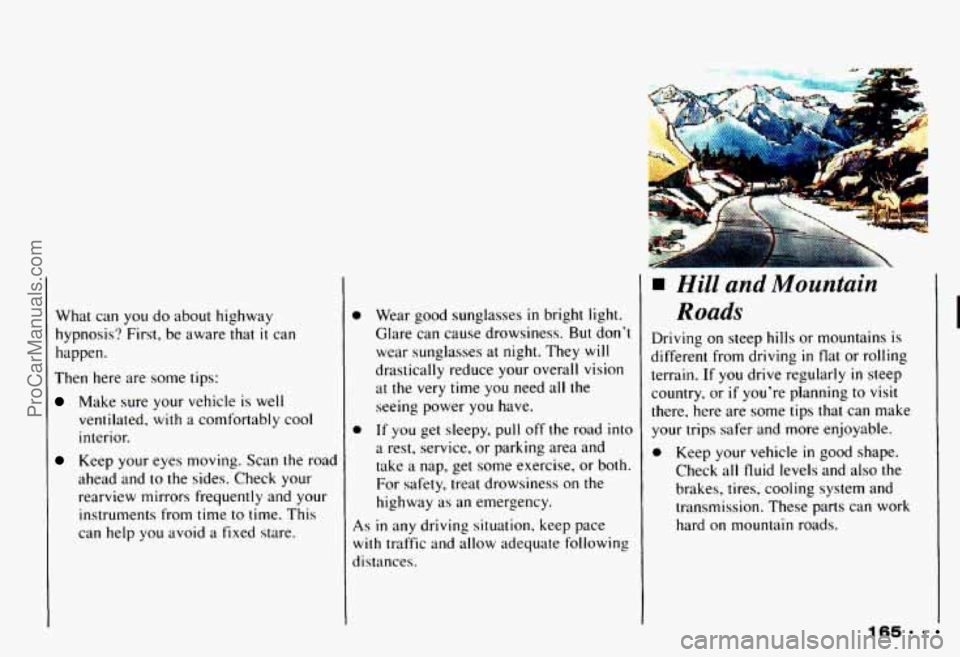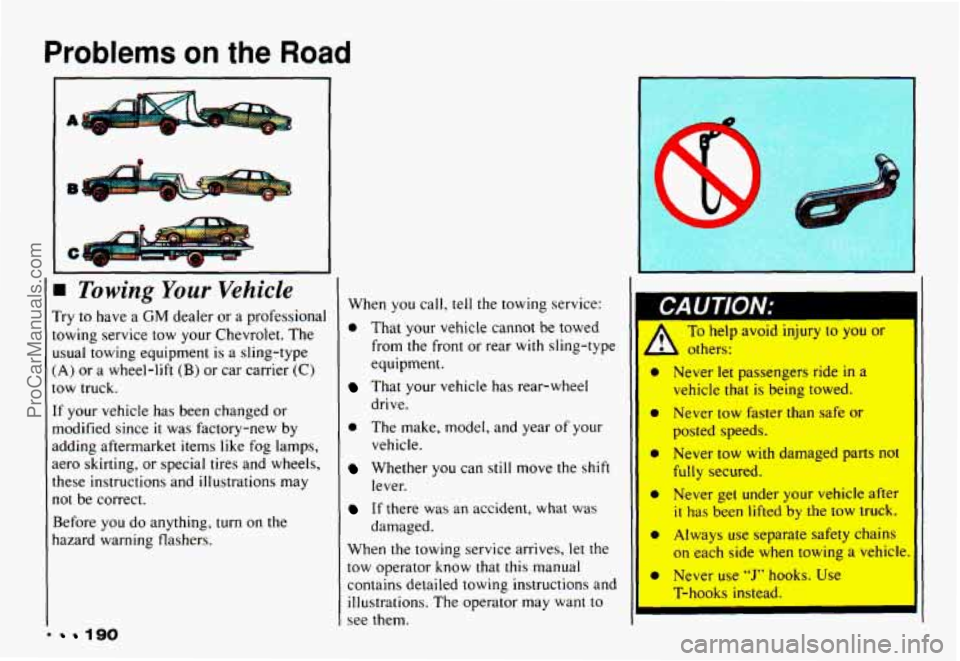Page 167 of 358

Driving a Long
Distance
Although most long trips today are made
on freeways, there are
still many made on
regular highways.
Long-distance driving on freeways and
regular highways
is the same in some
ways. The
trip has to be planned and the
vehicle prepared, you drive at
higher-than-city speeds, and there are
longer turns behind the wheel. You’ll
enjoy your trip more
if you and your
vehicle are
in good shape. Here are some
:ips for a successful long trip.
Before Leaving on a Long Trip
Make sure you’re ready. Try to be well
rested. If you must start when you’re not
fresh
- such as after a day’s work -
don’t plan to make too many miles that
first part of the journey. Wear comfortable
clothing and shoes you can easily drive
in.
Is your vehicle ready for a long trip? If
you keep
it serviced and maintained, it’s
ready to go. If
it needs service, have it
done before starting out. Of course, you’ll
find experienced and able service experts
in Chevrolet dealerships all across North
America. They’ll be ready and willing to
help
if you need it. Here
are some things you can check
before a trip:
0
0
0
0
0
Windshield Washer Fluid: Is the
reservoir
full? Are all windows clean
inside and outside?
Wiper Blades: Are they in good
shape?
Fuel, Engine Oil, Other Fluids:
Have you checked all levels?
Lights: Are they all working? Are the
lenses clean?
Tires: They are vitally important to a
safe, trouble-free trip.
Is the tread
good enough for long-distance
driving? Are the tires all inflated to
the recommended pressure?
163 -
ProCarManuals.com
Page 169 of 358

What can you do about highway
hypnosis'? First, be aware that
it can
happen.
Then here are some tips:
Make sure your vehicle is well
ventilated,
with a comfortably cool
interior.
Keep your eyes moving. Scan the road
ahead and
to the sides. Check your
rearview mirrors frequently and your
instruments from time
to time. This
can help you avoid a fixed stare. Wear
good sunglasses
in bright light.
Glare can cause drowsiness.
But don't
wear sunglasses
at night. They will
drastically reduce your overall vision
at
the very time you need all the
seeing power you have.
If you get sleepy,
pull off the road into
a rest, service, or parking area and
take a nap, get some exercise, or both.
For safety, treat drowsiness on the
highway as an emergency.
As in any driving situation. keep pace
with traffic and allow adequate following
distances.
Hill and Mountain
Roads
Driving on steep hills or mountains is
different from driving
in flat or rolling
terrain. If you drive regularly
in steep
country. or
if you're planning to visit
there, here are some tips that can make
your trips safer and more enjoyable.
0 Keep your vehicle in good shape.
Check all fluid levels and also the
brakes, tires, cooling system and
transmission. These parts can work
hard on mountain roads.
1659 *
ProCarManuals.com
Page 185 of 358
Maintenance When Trailer Towing
Your vehicle will need service more often
when you're pulling a trailer. See the
Maintenance Schedule for more on this.
Things that are especially important
in
trailer operation are automatic
transmission
fluid (don't overfill), engine
oil, axle lubricant. belts. cooling system,
and brake adjustment. Each of these is
covered
in this manual, and the Index will
help you find them quickly. If you're
trailering, it's
a good idea to review these
sections before
you start your trip.
Check periodically to see that all hitch
nuts
and bolts are tight.
ProCarManuals.com
Page 193 of 358
8. Now connect the black negative (-)
cable to the good battery's negative
(-) terminal.
Don't
let the other end touch anything
until the next step. The other end of
the negative cable doesn't go to the
dead battery. It goes to a heavy
unpainted metal part
on the engine of
the vehicle with the dead battery.
9.
10.
11.
Attach the cable at least 18 inches
(45 cm) away from the dead battery.
but
not near engine parts that move.
The electrical connection is just as
good there, but the chance of sparks
getting back to the battery is much
less.
Now start the vehicle with the good
battery and run the engine for a
while.
Try
to start the vehicle with the dead
battery.
If it won't start after a few tries, it
Probably needs service.
12. Remove the cables in reverse order
to prevent electrical shorting. Take
care that they don't touch each other
or any other metal.
A. Heavy Metal Engine Part
B. Good Battery
C. Dead Battery
ProCarManuals.com
Page 194 of 358

Problems on the Road
A
le
=Towing Your Vehicle
Try to have a CM dealer or a professional
towing service tow your Chevrolet. The
usual towing equipment is a sling-type
(A) or a wheel-lift (B) or car carrier (C)
tow truck.
If your vehicle has been changed or
modified since
it was factory-new by
adding aftermarket items like fog lamps,
aero skirting, or special tires and wheels,
these instructions and illustrations may
not be correct.
Before you do anything,
turn on the
hazard warning flashers.
190
When you call, tell the towing service:
0 That your vehicle cannot be towed
from the front or rear
with sling-type
equipment.
drive.
That your vehicle has rear-wheel
0 The make, model, and year of your
Whether you can still move the shift
If there was an accident, what was
When the towing service arrives, let the
tow operator know
that this manual
contains detailed towing instructions and
illustrations. The operator may want
to
see them.
vehicle.
lever.
damaged.
1
TO help avoid injury to you or
0
0
0
e
a
0
b others:
Never let passengers ride in a
vehicle that is being towed.
Never tow faster than safe
or
posted speeds.
Never
tow with damaged parts not
fully secured.
Never
get under your vehicle after
it has been lifted by the tow truck.
Always use separate safety chains
on each side when towing a vehicle,
Never use “J” hooks. Use
T-hooks instead.
ProCarManuals.com
Page 195 of 358

When your vehicle is being towed, have
the ignition
key off. The steering wheel
should be clamped
in a straight-ahead
position,
with a clamping device designed
for towing service.
Do not use the
vehicle’s steering column lock for this.
The transmission should be in Neutral
and the parking brake released.
Don’t have your vehicle towed on the rear
wheels, unless you must.
If the vehicle
must be towed on the rear wheels, don’t
EO more than 35 mDh (55 kmh) or I
CAUTION:
RA
I Front Towing Hook-Ups
A vehicle can fall from a car
Attach T-hook chains to slots in frame
carrier if
it isn’t properly rearward of front wheels on both sides.
secured. This can cause a collision,
tightly secured with chains or steel
cables before
it is transported.
Don’t
use substitutes (ropes, leather
straps, canvas webbing, etc.) that
can be cut by sharp edges
underneath the towed vehicle.
Farther than
50 miles (80 km j or your
transmission
will be damaged. If these
limits must be exceeded, then
the rear
wheels have to be supported on
a dolly.
I.
I
Do not attach winch cables or
1 hooks to suspension components
en using car carrier equipment
I Always use T-hooks inserted in the
I I
I T-hook slots. II
191 ProCarManuals.com
Page 199 of 358

If you get the overheat warning with no
sign of steam,
try this for a minute or so:
1. If you have an air conditioner, turn it
2. Turn on your heater to full hot at the
off.
highest fan speed and open
the
window
as necessary.
3. Try to keep your engine under load (in
a drive gear where the engine runs
slower).
If you no longer have the overheat
warning, you can drive. Just
to be safe,
drive slower for about
ten minutes. If the
warning doesn’t come back on,
you can
drive normally. If
the warning
continues, pull over, stop,
and park your vehicle right away.
If there’s
still no sign of steam, you can
idle
the engine for two or three minutes
while you’re parked, to see
if the warning
stops.
But then, if you still have the
warning, TURN
OFF THE ENGINE
AND GET EVERYONE OUT
OF THE
VEHICLE
until it cools down.
You may decide not to
lift the hood but to
get service help right away.
Cooling System
When you decide it’s safe to lift the hood,
here’s what you’ll see on the V6 engine:
1.
2.
3.
Coolant recovery tank
Radiator pressure cap
Electric engine
fan
ProCarManuals.com
Page 208 of 358
Problems on the Road
I lh
1
F. $. '
9. Shut the engine off and replace the
pressure cap. Be sure the arrows
on
the cap line up like this.
Y CI.
10. Then fill the coolant recovery tank
For a complete drain. flush and refill, see
your Chevrolet dealer or a Chevrolet
Carnaro Service
Manual. To purchase
a service manual, see "Service
Publications"
in the Index.
to the proper level.
If a Tire Goes Flat
It's unusual for
a tire to "blow out" while
you're driving, especially
if you maintain
your tires properly.
If air goes out of a
tire, it's much more likely
to leak out
slowly.
But if you should ever have a
"blowout," here are a few tips about what
to expect and what to do:
If a front tire fails, the flat tire will create
a drag that pulls the vehicle toward that
side. Take your foot off the accelerator
pedal and grip the steering wheel firmly.
Steer
to maintain lane position, then
gently brake to a stop well out of
the
traffic lane.
ProCarManuals.com